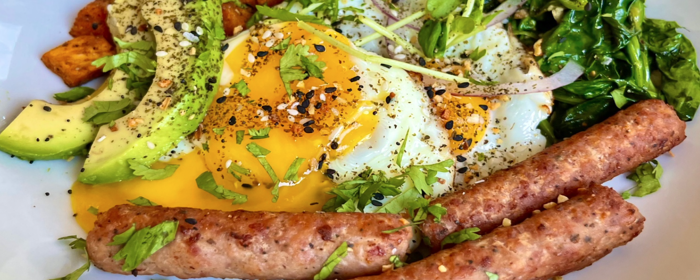
by admin | Jun 6, 2024 | Health Awareness
They say breakfast is the most important meal of the day, and rightly so. It sets the tone for your energy levels, metabolism, and overall well-being throughout the day. If you’re looking to revamp your morning routine, consider adding more protein to your breakfast. In this blog, we’ll explore the reasons why protein can be a game-changer for your morning meal.
1. Sustained Energy:
Protein is a macronutrient that takes longer to digest than carbohydrates. When you consume protein in the morning, it provides a steady release of energy over several hours. This means you’re less likely to experience mid-morning energy slumps or cravings for sugary snacks.
2. Appetite Control:
Protein is well-known for its appetite-suppressing effects. When you have a protein-rich breakfast, you’ll likely feel full and satisfied for longer. This can help you avoid overeating later in the day and support your weight management goals.
3. Muscle Maintenance and Growth:
Protein is essential for the repair and growth of muscles. If you engage in regular physical activity, a protein-rich breakfast can aid in muscle recovery and maintenance. This is particularly important for those who work out in the morning.
4. Improved Metabolism:
Protein has a higher thermic effect, meaning it requires more energy to digest compared to carbohydrates or fats. This increased calorie expenditure can boost your metabolism, helping you burn more calories throughout the day.
5. Better Blood Sugar Control:
Eating a balanced breakfast with adequate protein can help stabilize your blood sugar levels. This prevents the rapid spikes and crashes that often result from consuming high-sugar breakfasts. Stable blood sugar levels are key to overall health, particularly for individuals with diabetes or those at risk of developing the condition.
6. Enhanced Cognitive Function:
Protein provides the amino acids necessary for the production of neurotransmitters like dopamine and serotonin, which can improve mood and cognitive function. A protein-rich breakfast can help you stay mentally alert and focused throughout the morning.
7. Versatile and Delicious Options:
Adding more protein to your breakfast doesn’t mean you’re limited to one type of food. There are numerous protein-rich breakfast options to choose from, such as eggs, Greek yogurt, cottage cheese, nut butter, and lean meats. You can also include protein in your morning smoothie with ingredients like protein powder or chia seeds.
Balancing Your Breakfast:
While increasing protein in your breakfast is beneficial, it’s important to maintain a balanced meal. Pair your protein source with whole grains, fruits, and vegetables to create a nutritious and well-rounded breakfast.
Starting your day with a protein-packed breakfast is a simple and effective way to support your energy, appetite, and overall well-being. Whether you’re looking to manage your weight, stay focused at work, or improve your athletic performance, protein can be a valuable addition to your morning routine. So, give it a try and enjoy the benefits of a protein-powered breakfast!
Please visit more Health Awareness blogs on our website for more helpful information.

by Stemedix | Jun 3, 2024 | Age Management, Hair Regrowth, Health Awareness, PRP, Regenerative Medicine, Stem Cell Research, Stem Cell Therapy
Your hair can be part of your identity. For some people, their hair is a symbol of their spiritual beliefs. Whether you’re focused on beauty and aesthetics or a deeper meaning behind your hair, hair loss can be devastating.
For some people, regenerative medicine is an innovative, research-based solution to hair loss. Learn more about how regenerative hair loss treatments may restore your healthy locks.
How Hair Loss Is Related to Your Well-Being
Losing hair is often a symptom of an underlying health problem. While some people experience hair loss due to genetics or lifestyle choices, others may face lurking medical issues. Here are some of the ways your hair growth (or lack thereof) is related to your physical and mental wellness.
Self-Esteem and Confidence
You may feel embarrassed, ashamed, or self-conscious if you start to lose your hair. Both men and women struggle with remaining confident after significant hair loss. Your mental well-being may suffer if you can’t get your hair to grow back on its own.
Some cultures associate losing hair with aging and other stereotypes. This can be devastating for someone going through medical, hormonal, or age-related hair loss. Healthy hair regrowth may help you regain the confidence you lost.
Hormones
Your hormones are chemical messengers that regulate all of your body’s processes. Hair growth is tied to your hormones, and any fluctuations or declines in certain hormones can lead to losing hair. Think about post-pregnancy hair shedding; this happens because your body’s cascade of pregnancy hormones changes.
Hormonal changes as you get older can affect your hair. Age-related hair loss and thinning primarily affect women due to declines in estrogen production, but this problem can affect men as well.
Genetic Baldness
Male-pattern baldness is passed down through families. If you carry the gene for this condition, you may experience very early balding, starting in your 20s or 30s. This can change your appearance and make you feel older than you really are.
There are no ill physical effects from male-pattern baldness besides losing hair. However, you may experience poor mental health as a result of your unwanted early hair loss and thinning.
There is no cure for male-pattern baldness, but you can take steps to treat it. Regenerative medicine is here to intervene and treat hair loss in a natural, science-based way.
ExogroPro: The Latest in Hair Regrowth Science
When you experience hair loss of any kind, you probably have two priorities — prevent further hair loss and replenish your missing hair. ExogroPro, a professional-grade hair loss solution, addresses both of these problems at once.
How It Works: Preventing Further Hair Loss and Regrowing Lost Hair
ExogroPro works to stimulate your hair follicles, causing them to grow healthy hair again. This treatment uses the power of specific exosomes, which carry materials between your cells.
ExogroPro is designed to send signals to your hair follicles that stimulate hair growth. Because of exosomes’ extracellular communication abilities, they may be able to revive “dead” hair follicles on your head.
Because of this treatment’s therapeutic effects on hair follicle health, it may help prevent further hair loss and thinning. By rejuvenating your hair follicles and preventing them from going dormant, ExogroPro offers a possible solution to unwanted lost hair.
The Procedure: What to Expect
The premium patent pending ExogroPro formula is injected into the scalp to deliver exosomes to the hair follicles. These exosomes originate from human stem cells, specifically mesenchymal stem cells. This is just another way we can harness the power of stem cells to regenerate and repair damaged tissues within your body.
After two to six months, you may notice your hair growing back thicker and fuller than before. The results window varies, but one thing is certain — hair regrowth is worth the wait.
The Benefits of Choosing Regenerative Medicine for Hair Growth
With many prescription hair growth drugs on the market, you may be wondering — why choose ExogroPro? Here are the major benefits of choosing regenerative medicine for hair regrowth and thickening.
May Be More Effective Than Traditional Treatments
There are numerous treatments for hair loss, including PRP injections, topical oils, and more. These have varying efficacy and likely won’t give you the results you’re looking for. Prescription-strength hair growth drugs may not work for you either, resulting in frustration and discouragement.
Regenerative medicine harnesses the power of science and innovation. By using human stem cells, we work with the body processes already in place within your system. Exosomes may prove to be more effective and efficient than other hair loss solutions.
Drug-Free Therapy
Exosomes are naturally found in the human body. When you choose ExogroPro, you choose drug-free natural therapy for your hair and scalp.
While prescriptions can be helpful for some people facing hair loss, it’s understandable to want a natural alternative. We work with your natural healing and regrowth processes, not against them.
Dual-Action Treatment: Prevention and Active Regrowth
It’s impressive to consider how ExogroPro not only prevents further lost hair but can revive faulty hair follicles. This dual mechanism is key to getting the full head of hair you’re after. If it works for you, you’ll no longer have to mourn the hair you’ve lost — you could potentially get it back!
Encourages Hair Health
Solving hair loss isn’t just about replacing lost hair. It’s also about growing healthy, strong locks that can withstand damage and remain intact. ExogroPro promotes hair follicle health by improving cellular communications in the injected tissues. What’s more promising than the idea of a full, healthy head of hair after hair loss and thinning?
Combating Hair Loss and Thinning with Medical Science
It’s important to seek evidence-based treatments for your hair loss. No matter what the root cause of your hair problems is, you may find regenerative medicine to be a viable solution.
You don’t have to mourn your lost hair forever. Regenerative medicine is at the forefront of medical innovation and science, which could spell good news for your hair.

by admin | May 30, 2024 | Health Awareness
High blood pressure, or hypertension, is a common health concern affecting millions of people worldwide. While medications can help control it, lifestyle changes can also make a significant impact. Regular exercise has been identified as a powerful tool for reducing blood pressure naturally. In this blog post, we’ll explore the best exercises to lower blood pressure and understand why they are so effective.
Understanding Blood Pressure:
Before we delve into the exercises, it’s crucial to grasp the basics of blood pressure. Blood pressure is the force of blood against the walls of your arteries. It consists of two values: systolic pressure (when the heart beats) and diastolic pressure (when the heart rests). High blood pressure puts extra strain on your heart and can lead to serious health issues, such as heart disease and stroke.
The Best Exercises for Lowering Blood Pressure:
Aerobic Exercise:
How it works: Aerobic exercises, like brisk walking, jogging, cycling, and swimming, elevate your heart rate and promote the flow of oxygen-rich blood through your arteries.
Why it’s effective: Consistent aerobic exercise helps improve the efficiency of your cardiovascular system, making your heart pump more blood with each beat and your blood vessels more elastic.
Strength Training:
How it works: Strength training, involving resistance exercises like weight lifting and bodyweight exercises (e.g., push-ups and squats), stimulates muscle growth and helps reduce the stiffness of arteries.
Why it’s effective: Strength training enhances blood vessel function, aids in weight management (a key factor in blood pressure control), and contributes to overall cardiovascular health.
Why Exercise Works:
Exercise promotes several positive changes in the body that can help lower blood pressure, including:
Weight Management: Regular exercise helps control weight, which is closely linked to blood pressure. Maintaining a healthy weight reduces the stress on the heart.
Reducing Arterial Stiffness: Both aerobic exercise and strength training can improve blood vessel function, reducing the stiffness of arteries and promoting better blood flow.
Stress Reduction: Physical activity triggers the release of endorphins, which can help reduce stress and anxiety, contributing to lower blood pressure.
Consult Your Healthcare Provider:
While exercise can be a powerful tool for managing blood pressure, it’s essential to consult your healthcare provider before starting a new exercise regimen, especially if you have pre-existing health conditions. They can provide guidance and recommendations tailored to your specific needs.
Exercise is a natural and effective way to lower blood pressure and promote overall cardiovascular health. Incorporating both aerobic and strength training exercises into your routine can have a positive impact on your well-being. By taking control of your health through regular physical activity, you’re not only reducing the risk of hypertension but also investing in a healthier, happier future.
Please visit more Health Awareness blogs on our website for more helpful information.

by Stemedix | May 27, 2024 | Health Awareness, Neurodegenerative Diseases, Parkinson's Disease, Stem Cell Research, Stem Cell Therapy
Getting any serious medical diagnosis can be frightening and intimidating. You might be unsure of what to do next or how to manage your condition. When it comes to Parkinson’s disease, the future can be even more uncertain since it’s a progressive neurodegenerative condition. It’s important to make a plan for how you’ll proceed after receiving a Parkinson’s diagnosis. You aren’t alone on your journey. Here are some steps you can take after your doctor tells you that you have Parkinson’s disease.
Understanding Your Diagnosis
Before you make an action plan, you should fully understand your Parkinson’s diagnosis. It’s important to know how this disease can affect your physical, mental, and social health in the future.
Parkinson’s Symptoms
Every person with Parkinson’s experiences the disease slightly differently. However, there are some common symptoms to watch out for as the disease progresses.
Common Parkinson’s symptoms include:
- Muscle tremors
- Insomnia
- Muscle stiffness
- Slow movements
- “Shuffle walk”
- Hunched or stooped posture
- Small handwriting
- Sudden soft or low speech
- Mood swings
- Sudden weight loss
- Decreased appetite
- Poor balance and coordination
- Dizziness and fainting
These are just a few of the warning signs and symptoms that Parkinson’s is progressing. Often, motor symptoms are the giveaway that someone has Parkinson’s over other diseases. It’s important to get an official diagnosis from a physician before seeking treatment.
What Causes Parkinson’s Disease?
The cause of Parkinson’s disease is the degeneration of neurons in the brain that produce dopamine. Dopamine is a neurotransmitter that helps control voluntary movements, and without enough of it, your movements become uncoordinated or involuntary.
Researchers don’t yet know the exact cause of Parkinson’s. The disease may have genetic components, but it seems to appear in combination with environmental triggers.
Certain risk factors make it more likely for someone to develop Parkinson’s. These factors include being male or over the age of 60. However, these risk factors aren’t guarantees that someone will develop this disease.
Is There a Cure?
There is currently no cure for Parkinson’s disease. Since it’s a neurodegenerative condition, the neurons that produce dopamine will continue to die off over time. However, modern innovative treatments like stem cell therapy may slow the progression of your symptoms to improve your quality of life.
You can also make lifestyle changes to mitigate some of the movement-related symptoms of Parkinson’s. Exercise and a healthy diet can keep you in good physical and mental shape, giving you a better ability to fight this disease.
Start Tracking Your Symptoms
After you’ve been diagnosed with Parkinson’s disease, you should start tracking your symptoms. Whether you use an app or a paper journal, it’s important to notice trends and patterns in your symptom development. These records will also help your doctor or Parkinson’s specialist come up with the best treatment plan for you.
You can break your symptoms down by category — movement, cognition, speech and swallowing, and other common groups of Parkinson’s symptoms. Then, record the date and severity of each symptom, noting any concerning developments along the way.
It may give you a greater sense of control and autonomy to keep track of what’s happening in your body as the disease progresses.
Piece Together a Treatment Team
Your doctor or Parkinson’s specialist may already have a treatment team for you, but if not, consider taking the steps to make your own. This may mean visiting different offices, seeking alternative therapies, and communicating with other Parkinson’s providers.
The more professionals you have on your side, the more robust and effective your treatments can be. Encourage your treatment team to communicate via medical charting or telephone so everyone can be on the same page. Always report any changes to your treatments to your primary care doctor or Parkinson’s specialist.
Get Plenty of Exercise and Gentle Movement
One of the best ways to slow the progression of Parkinson’s and retain your motor skills is to exercise. Whether you choose low-intensity activities, like walking or gentle stretches, know that you’re making healthy choices for your body.
The more your brain and body connect to produce voluntary movements, the stronger those connections become, which may help delay the onset of more severe movement symptoms. If you’ve never been physically active, now is the time to start.
There are low-impact exercises that don’t put stress and pressure on your joints. These include swimming, cycling, yoga and stretching, and elliptical workouts. Don’t feel like you have to push yourself to the max — any movement at all is healthy for you.
Improve Your Nutrition
The foods you eat play a large role in how you feel. If your diet is full of processed and refined foods, you may experience inflammation, fatigue, and other symptoms.
Eating a well-balanced diet with plenty of fruits and vegetables can keep you in good shape. Fruits and vegetables contain antioxidants, which are natural substances that fight aging and tissue damage.
If your goal is to slow the progression of Parkinson’s, incorporating more of these whole foods into your diet can’t hurt. See a registered dietician if you need help curating a healthy, well-rounded diet after a Parkinson’s diagnosis.
Evaluate and Try Different Treatments
Parkinson’s has no cure, but there are interventions and medical therapies that may help with your symptoms. From prescribed medications to holistic therapies to regenerative medicine, your options are plentiful.
Regenerative medicine, in particular, may offer surprising positive results for your Parkinson’s symptoms. Interventions like stem cell therapy for Parkinson’s may help reverse some of the cellular damage caused by this disease. These treatments get to the root cause of your symptoms and have the potential to improve your quality of life.
Physical therapy and speech therapy can be helpful for many Parkinson’s patients. These interventions help you regain motor control and improve your speech once the disease has started to interfere with these functions.
Staying Hopeful After a Parkinson’s Diagnosis
It’s important for you to have a strong support system, both medically and socially, to get through Parkinson’s disease. While it can be difficult, staying hopeful and cultivating gratitude can keep your mind in a positive place as you fight these symptoms. Never give up on yourself and your health, even if you’ve been diagnosed with a neurodegenerative condition.

by Stemedix | May 20, 2024 | Multiple Sclerosis, Age Management, Health Awareness, Regenerative Medicine, Stem Cell Research, Stem Cell Therapy
Some health conditions don’t yet have definite cures. Multiple sclerosis (MS) is one of them. While there is no known cure, several new treatments are emerging that show great potential in treating MS. Stem cell therapy for multiple sclerosis can be life-changing. If you struggle with debilitating symptoms and everyday life is painful for you, regenerative medicine may be able to help. Here’s everything you need to know about using stem cell treatments to address MS symptoms.
Multiple Sclerosis: Causes and Symptoms
Multiple sclerosis is a complex disease that researchers are still studying. Knowing the potential causes and common symptoms can help you monitor your condition and recognize when to seek treatment.
How MS Develops and What Causes It
Multiple sclerosis is a neurodegenerative disease. Your immune system starts attacking your nervous system, causing damage over time. Specifically, your immune system degrades the protective coating on your nerves. This coating is called the myelin sheath, and it’s essential for proper nerve function.
The faulty immune response in patients with MS is triggered by certain environmental factors that turn on specific genes. In other words, you may be genetically predisposed to MS, and certain environments “switch on” the genes that activate the disease.
Scientists don’t yet know exactly what causes this activation, but it may be related to lifestyle factors. Smokers and people with inflammatory diets are at higher risk for developing this condition.
Common MS Symptoms
You may experience a combination of common MS symptoms. Certain symptoms may flare up and then go away for a while. During flare-ups, you’re more likely to experience pain and discomfort.
The most common symptoms of multiple sclerosis include:
- Numbness and tingling
- Vertigo
- Skin conditions
- Balance problems
- Difficulty with coordination
- Problems swallowing
- Trouble speaking
- Vision disturbances
- Eye pain
- Seizures
- Hearing problems or loss
- Intense nerve pain
Since MS affects your nervous system, it makes sense for it to impair your balance, coordination, and senses. This disease may eventually affect your optic nerve, or the nerves involved in hearing and auditory processing.
How MS Can Progress Without Treatment
You aren’t doomed to a life of pain and suffering if you’ve been diagnosed with MS. However, it can be a progressive neurodegenerative disease if left untreated.
Some patients experience a steady progression in sensory and motor problems because of MS. Others will have periodic flare-ups that go away and come back randomly. You may notice that stress, lack of sleep, and poor nutrition trigger flare-ups for you.
If left completely untreated, the protective coatings on your nerves will start to degrade, and the affected nerves will stop working properly. This is what leads to trouble swallowing, walking, speaking, seeing, and hearing.
Innovative treatments like stem cell therapy may improve your prognosis with MS. Regenerative medicine may help repair some of the nerve damage caused by your immune responses, addressing the root cause of your symptoms.
What Is Stem Cell Therapy for MS?
Stem cells are known for their ability to regenerate and repair tissues in the body. In lab environments, stem cells can be “programmed” to develop into the necessary cells needed for wound healing, tissue regeneration, and reducing inflammation.
These restorative cells can also renew themselves, keeping injured and diseased areas supplied with plenty of stem cells to continue healing and repairing themselves. That’s why stem cell therapy is so potent — once the stem cell repair process starts, it can continue on its own.
Multiple sclerosis leads to nerve and tissue damage over time, and stem cells may be able to reverse some of that damage. By modulating your immune responses, combating inflammation, and replacing damaged tissues, stem cells can significantly improve your MS symptoms.
The Benefits of Stem Cell Therapy for Multiple Sclerosis Patients
You have several options when it comes to MS treatments. There are medications and alternative therapies designed to combat MS symptoms and nerve damage. However, stem cell therapy offers unique advantages you should consider before selecting your treatment(s).
Drug-Free Therapy
Stem cells are not pharmaceutical compounds. They are natural cells every human body produces and keeps around for wound healing and tissue repair. Since this therapy is drug-free, there are fewer risks involved — like medication side effects and allergies.
Some patients choose to take MS medication in conjunction with stem cell therapy. Only you can decide what treatment routes are best for you. However, if you want to go drug-free, stem cell therapy is a potent option for you.
Get Behind the Symptoms
Regenerative medicine does more than just mask your symptoms or cover up pain. It gets to the root causes of your MS challenges, including nerve damage and inflammation. By using stem cells to target areas of damage and discomfort, you may be able to improve your future with this disease.
Innovative Treatments
Regenerative medicine is at the forefront of medical science. Researchers are learning new information about MS and stem cells every year, and you can be a part of this experience. By choosing stem cell therapy, you get to benefit from the latest advancements in natural healing and recovery.
Slower Disease Progression
Since MS can be progressive, it’s important to seek treatment as soon as possible. Stem cell therapy may prevent your symptoms from getting worse and debilitating you, as well as improve your future health outcomes with Multiple Sclerosis. Whether you suffer from periodic flare-ups or progressive degeneration, regenerative medicine can help.
Navigating Your Future With MS
It can be devastating to receive a diagnosis like multiple sclerosis. However, it’s important not to lose hope. As medical science progresses forward, there are new and innovative treatments around every corner.
Regenerative medicine gives you the opportunity to take advantage of the latest advancements in this area of science and research. You can use it in conjunction with other interventions as specified by your physician.
No matter what treatments you choose to battle your MS symptoms, know that you’re never alone. Your condition does not define you.

by Stemedix | May 6, 2024 | Age Management, Health Awareness, Neurodegenerative Diseases, Parkinson's Disease
Parkinson’s disease affects your fine and gross motor skills. It might seem counterintuitive to try to exercise after your diagnosis, but physical activity is crucial. For seniors with Parkinson’s disease, exercise can boost mood, improve physical health, and improve motor skills.
Not sure where to start? Even just a few minutes of gentle exercise each day can help. Here’s what you need to know about exercising as a senior with Parkinson’s.
How Parkinson’s Disease Affects Your Nervous System
Parkinson’s affects sensory and motor skills in your body due to its effects on your nervous system. Your nerves are responsible for coordinating movements and sending signals to your muscles. When this system is flawed, motor problems arise.
Low Dopamine Levels
Patients with Parkinson’s disease have lower-than-normal levels of dopamine, a neurotransmitter in the brain. Dopamine is very important in voluntary movement. Parkinson’s is a neurodegenerative condition, which means it can progress over time as dopamine levels can steadily decline.
Problems With Executive Functioning and Cognition
Thinking, speech, and executive functioning are all impacted by Parkinson’s disease. Seniors with Parkinson’s may have difficulty feeling mentally clear, planning things, speaking, and remembering.
It makes sense that a neurodegenerative condition like Parkinson’s would impact a person’s cognition. After all, these changes originate in the brain. Luckily, exercise may have a protective effect for seniors with Parkinson’s-related cognitive problems.
Motor Problems
The symptoms of Parkinson’s disease include many different motor control problems. Often, tremors or problems balancing are among the first symptoms for seniors with Parkinson’s.
Movement and muscle-related symptoms include:
- Muscle stiffness
- Balance and coordination problems
- Changes in gait (walk)
- Tremors and involuntary shakes
- Handwriting changes
- Difficulty standing and walking
- Muscle contractions
These symptoms can interfere with your daily life, especially as your condition progresses. Exercise has therapeutic effects for seniors diagnosed with Parkinson’s disease. If you’re struggling with your symptoms, it’s worth a try.
How Exercise Benefits Seniors with Parkinson’s
Exercise is healthy for everyone, but it can be especially beneficial for Parkinson’s patients. Physical activity, including aerobic exercise and strength training, may have protective effects on the brain. This is key when it comes to preventing further progression of your Parkinson’s symptoms.
Balance and Coordination and Skills
Most types of exercise involve muscle coordination and balance. Even on a small scale, these exercises give your brain and body practice in strengthening your coordination and balance skills.
In seniors with Parkinson’s, balance and motor coordination are usually the first two abilities to weaken. Performing low-intensity strength training exercises, yoga, or dance exercises can strengthen these abilities and prevent further decline.
Muscle Tone and Strength
Seniors with Parkinson’s may develop low muscle tone and reduced strength. This happens when Parkinson’s limits your ability to control your muscles and engage in intentional movements.
Exercise can improve your muscle tone and strength through repetition and low-intensity training. Lifting light weights, like dumbbells or kettlebells, can train your muscles to move with intention and improve their function.
Cognitive Functioning
Physical activity of any kind boosts your neurological health. It helps your brain form new neural pathways and enforces new connections. This can be incredibly beneficial in slowing the progression of Parkinson’s disease.
Exercise may lead to better memory, cognition, and reasoning skills. It can also boost your speech and emotional regulation abilities as the disease progresses.
Working out will also keep your body in good shape, which is always helpful for slowing the aging process. Whether you have a disease or not, exercise can keep you youthful and healthy.
Quality of Life and Mobility
Your health is the most precious thing you have, and exercise improves your health over time. If you’re a senior with Parkinson’s, it’s important not to lose hope. Studies show that you can reverse some of the neurodegeneration that occurs as Parkinson’s progresses through high-intensity exercise.
Along with improving your quality of life, mood, and motor control, exercise helps you stay mobile and flexible. Doing activities like yoga, stretching, and tai chi will help preserve your mobility in the face of Parkinson’s disease.
Best Exercises for Managing Parkinson’s Symptoms
Now that you know the medical benefits of exercising regularly as a senior with Parkinson’s, where should you start?
It might feel intimidating to jump into a new exercise routine, but even mild activities can be helpful. Here are some of the most beneficial Parkinson’s management exercises.
Walking Outdoors
Getting out in nature boosts your mood, brain health, and physical abilities more than you might think. Just taking a 10- to 20-minute walk outside can help you better manage your symptoms.
Walking helps you refine your gait and avoid the “Parkinson’s shuffle” that many seniors fall victim to. By using your leg muscles and coordination to walk often, you’re making it easier for your body to carry this movement out properly over time.
Aerobic Exercises
Cardio does wonders for the brain and body. Aerobic exercise includes anything that gets your heart rate up, including jogging, swimming, and jumping rope. When it comes to Parkinson’s disease, aerobic exercise can boost your brain activity and health to help reduce cognitive decline.
Cardio also releases endorphins, which are feel-good hormones that boost your mood and improve your mental health!
If you’re new to cardio exercises, start slow. Walking is considered to be a form of cardio, and when you’re ready to increase the intensity of your workouts, you can do so steadily.
Flexibility Training: Yoga and More
It’s important to gently stretch your soft tissues to keep them elastic and prevent stiffness. As you live with Parkinson’s disease, flexibility is more important than ever. The more flexibility and mobility you maintain, the fewer complications you’ll have with movement in your daily life.
Consider signing up for an outdoor yoga class or group tai chi session to motivate you. These classes are usually designed to accommodate all fitness and ability levels, making them the perfect choice for seniors with Parkinson’s.
Parkinson’s and Exercise: Improve Your Quality of Life
You don’t have to sit back and let Parkinson’s disease take the reins of your life. Exercise has seemingly endless benefits for your physical, mental, and neurological health. Make exercise a priority so you can enjoy an improved quality of life as you navigate the world after a Parkinson’s diagnosis.







 St. Petersburg, Florida
St. Petersburg, Florida
